|
The butterflies - probably the best known group of invertebrates - are sensitive to environmental changes and
therefore serve as most valuable indicators by providing indispensable information on the state of the environment
in Europe under the impact of changing land use practices and other anthropogenic pressures. Numerous butterfly
species are considered to be threatened by such pressures and many have been given legal protection on a regional,
national, European or even world-wide scale.
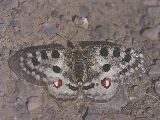
 Parnassius apollo (D, Mosel)
Parnassius apollo (D, Mosel)
|
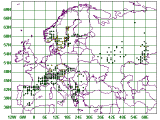
 The Distribution map of Parnassius apollo
The Distribution map of Parnassius apollo
| |
In spite of such conservation measures, until 1996 there had been no European data bank or adequate distribution maps
enabling scientists and European authorities to assess the bio-geographical status and the degree of threat to the
indigenous butterfly species. The distribution maps available in some field guides and similar books
(e.g. HIGGINS & RILEY 1970 and subsequent editions) featuring roughly the western half of Europe reduced to the
miniature size of 23 x 37 mm are useless because of their small scale alone; in addition to this they are hopelessly
inaccurate. National data banks and distribution maps are no substitute for a European solution; quite apart from the fact that,
even at the time of writing these lines in the summer of 2001, they are only available for some European countries and
their standard differs to a great extent from case to case.
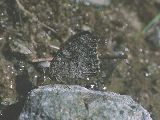
 Hipparchia cypriensis (Cyprus)
Hipparchia cypriensis (Cyprus)
|
| |
The first attempt to assess the status of European butterflies (HEATH 1981) was commissioned by the Council of
Europe - and inevitably failed in every way (KUDRNA 1986). The European Invertebrate Survey (EIS) has never come near
to fulfilling its 25 years-old pledge to produce a distribution atlas of European butterflies; the only attempt
(HEATH & LECLERQ 1981) contains distribution maps of only 10 of nearly 500 species (i.e. just over 2 % of species) and
these contain so many obvious errors, that they are also useless. The irresponsible approach of EIS towards its declared
aims is most deplorable. Many governmental and non-governmental authorities throughout Europe are still taking EIS
seriously, believing or assuming that EIS maintain comprehensive data banks and can provide expert advice on all
questions concerning the distribution of European butterflies. Moreover, representatives of EIS are members of
scientific committees regularly consulted by governments and European conservation authorities. In some countries, the
existence of EIS alone serves as a convenient excuse for the state authorities not to support national recording schemes
on the grounds that they would duplicate the work already carried out by the EIS. These facts are, particularly in view
of many international conventions and EU legislation, very hard to believe but are sadly true.

 Erebia euryale (CZ, Böhmerwald)
Erebia euryale (CZ, Böhmerwald)
|
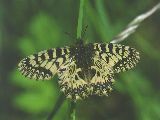
 Zerynthia polyxena (CZ, Brno)
Zerynthia polyxena (CZ, Brno)
| |
Against this background the Naturschutzbund Deutschland e.V. (NABU) and the Gesellschaft für Schmetterlingsschutz e.V.
(GfS) resolved in 1995 to start the project 'Mapping European Butterflies' (MEB) with the following main objectives:
- The setting-up of a distribution data bank for European butterflies.
- The publication of a distribution atlas of European butterflies (dot maps).
- The assessment of the conservation status of European butterfly species.
- The identification of high priority areas for the conservation of European butterflies.
- The identification of priorities in the conservation of European butterflies.
It was decided to achieve these five goals by the evaluation of the present distribution patterns of the European
butterfly species.

 Gonepteryx cleopatra (I, Sardinia)
Gonepteryx cleopatra (I, Sardinia)
|
| |
Originally, it was intended to complete the project not later than in the spring of 2000. The great complexity of the
project, building-up a team of recorders, the enormous amount of data received for processing and the time needed for
their processing, soon proved the original timetable to be unrealistic. Despite the two years delay in the publication
of the Atlas it must be pointed out that the project has been completed effectively and in a very short time.
For this project the following definition of Europe was adopted: Europe is the westernmost extremity of the Euroasiatic
landmass, bordered to the west by the Atlantic Ocean or adjacent off-shore seas and including adjacent off-shore islands.
Included are all three Atlantic Ocean island groups: the Azores, Madeira and Canary Islands; excluded is Iceland which
has no resident butterflies. The eastern border of Europe is marked by the Ural Mountains. The south-eastern border of
Europe is (as usual) somewhat arbitrary: Ural Mts. - Ural River - northern and western Caspian Sea coast southwards to
the town of Makhachkala - railway, road and oil pipelines from Makhachkala to the town of Mineralnye Vody - Nevinnomyssk -
Armavir - Kropotnik - Krasnodar - Novorossiysk - northern Black Sea Coast south-westwards (including the Crimea) -
eastern coast of European Turkey and Greece. Included are all Greek islands (regardless of how close to Asiatic Turkey
they may be), Cyprus, Malta and all Mediterranean islands forming any part of the territory of any European country.
Excluded is Asiatic Turkey (i.e. Asia Minor) and all African territories, including those under the administration of any
European country.

 Polyommatus daphnis (D, Rhön)
Polyommatus daphnis (D, Rhön)
|
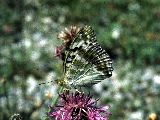
 Argynnis paphia f. valesina (D Rhön)
Argynnis paphia f. valesina (D Rhön)
| |
The butterflies (Rhopalocera) are understood to comprise the superfamilies Papilionoidea and Hesperioidea. All European
butterfly species recognised for the purpose of this project are listed separately, alphabetically arranged in an
annotated catalogue. Records of exceptional or incidental migrants are not considered.
Three recording periods are covered:
- Before and including 31 December 1950 (map symbol = open circle
 ) )
- Between 01 January 1951 and 31 December 1980 (map symbol = half dot
 ) )
- After and including 01 January 1981 (map symbol = full dot
 ) )
As the most recent records - in the first place those of the 3rd period and in the second place those of the
2nd period - are more important for conservation purposes than old records, the most recent record determines
the symbol on the map. As there is no standard chronological classification of butterfly records in Europe, data banks
of some countries extracted for MEB had to be adjusted to correspond with the above periods; these include those of the
following countries: Austria, Finland, France and Switzerland.
|
 Email to Webmaster
Email to Webmaster
 Email to Webmaster
Email to Webmaster